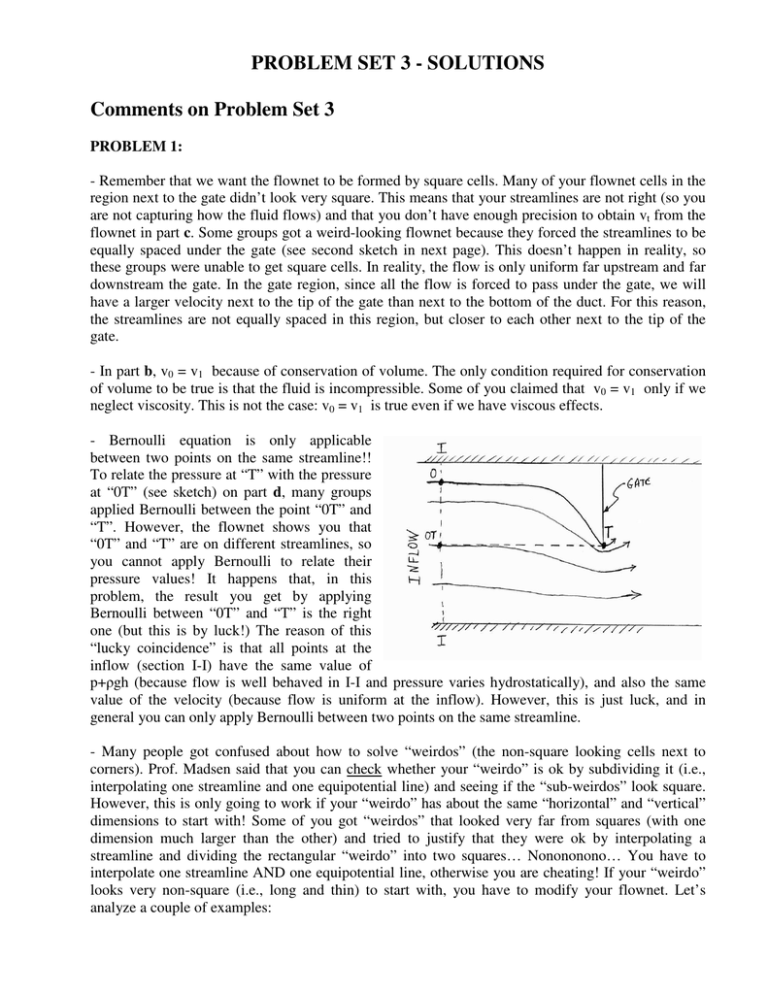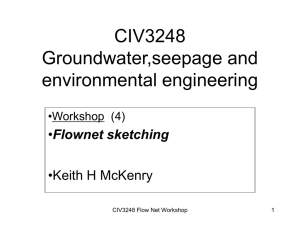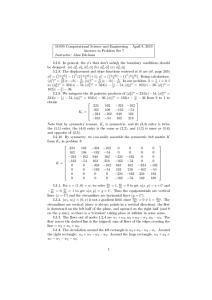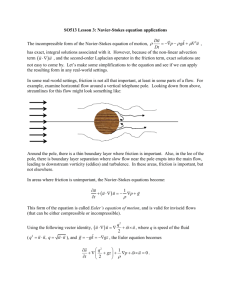PROBLEM SET 3 - SOLUTIONS Comments on Problem Set 3
advertisement

PROBLEM SET 3 - SOLUTIONS Comments on Problem Set 3 PROBLEM 1: - Remember that we want the flownet to be formed by square cells. Many of your flownet cells in the region next to the gate didn’t look very square. This means that your streamlines are not right (so you are not capturing how the fluid flows) and that you don’t have enough precision to obtain vt from the flownet in part c. Some groups got a weird-looking flownet because they forced the streamlines to be equally spaced under the gate (see second sketch in next page). This doesn’t happen in reality, so these groups were unable to get square cells. In reality, the flow is only uniform far upstream and far downstream the gate. In the gate region, since all the flow is forced to pass under the gate, we will have a larger velocity next to the tip of the gate than next to the bottom of the duct. For this reason, the streamlines are not equally spaced in this region, but closer to each other next to the tip of the gate. - In part b, v0 = v1 because of conservation of volume. The only condition required for conservation of volume to be true is that the fluid is incompressible. Some of you claimed that v0 = v1 only if we neglect viscosity. This is not the case: v0 = v1 is true even if we have viscous effects. - Bernoulli equation is only applicable between two points on the same streamline!! To relate the pressure at “T” with the pressure at “0T” (see sketch) on part d, many groups applied Bernoulli between the point “0T” and “T”. However, the flownet shows you that “0T” and “T” are on different streamlines, so you cannot apply Bernoulli to relate their pressure values! It happens that, in this problem, the result you get by applying Bernoulli between “0T” and “T” is the right one (but this is by luck!) The reason of this “lucky coincidence” is that all points at the inflow (section I-I) have the same value of p+ρgh (because flow is well behaved in I-I and pressure varies hydrostatically), and also the same value of the velocity (because flow is uniform at the inflow). However, this is just luck, and in general you can only apply Bernoulli between two points on the same streamline. - Many people got confused about how to solve “weirdos” (the non-square looking cells next to corners). Prof. Madsen said that you can check whether your “weirdo” is ok by subdividing it (i.e., interpolating one streamline and one equipotential line) and seeing if the “sub-weirdos” look square. However, this is only going to work if your “weirdo” has about the same “horizontal” and “vertical” dimensions to start with! Some of you got “weirdos” that looked very far from squares (with one dimension much larger than the other) and tried to justify that they were ok by interpolating a streamline and dividing the rectangular “weirdo” into two squares… Nonononono… You have to interpolate one streamline AND one equipotential line, otherwise you are cheating! If your “weirdo” looks very non-square (i.e., long and thin) to start with, you have to modify your flownet. Let’s analyze a couple of examples: This is an example of a reasonably good flownet. I have subdivided the upper-right weirdo (the one inside the circle) twice. First, I introduced a new streamline AND a new equipotential line (both are drawn as solid lines) to get four sub-weirdos that look reasonably square. Again, I subdivided the two upper sub-weirdos (now I used dashed lines) and get sub-sub-weirdos that are again reasonably square. Therefore, I conclude that the flownet looks right. This is an example of a bad flownet (copied from one of the answers to the problem set). The upper right weirdos look very long and thin, that is, not square at all. No matter how you try to subdivide them, there is no way you can get sub-weirdos that look square (unless you cheat interpolating streamlines only!). At the same time, the lower right cells look quite short and fat. The way of fixing this flownet is by re-drawing the streamlines upwards, and modifying the equipotential lines accordingly, to get something similar to the flownet in the previous example. Note that this correction is going to make the streamlines closer to each other near the tip of the gate, and therefore the value of vt from the corrected flownet is going to be larger. PROBLEM 2: - Most groups did well on this problem. However, most of you didn’t explain why the highest point of the siphon is the most critical one (i.e., has the smallest pressure). To justify this, you apply Bernoulli along the pipe (you can do this because the streamlines go along the pipe). Since p+ ρgh + ρv2/2 is constant along the pipe, and continuity dictates that velocity is the same everywhere, the pressure will be smallest when h is highest, i.e., the smallest pressure happens at the highest point. I guess most of you knew this, but many of you didn’t write it down (and lost a couple of points). As we (David and Sal) have already said a few times, many of the groups should give more details about their assumptions and calculations. PROBLEM 3: - You also did pretty well on this one, in general. Remember that if V(centerline) is within 3% of V(average), this means that 0.97 V(ave) < V(cl) < 1.03 V(ave). Some groups considered only one of the two limits. And again, try to give more detailed explanations of your solution procedure. Many groups didn’t explain very well how they got the result from the spreadsheet (the problem said “be sure to include sample calculations”!) And it’s considered not being nice with the TA to hand in a problem with a bunch of numbers and equations and not a single word… COMMENTS ON PROBLEMS 4 TO 6: Almost all groups made many careless math errors throughout (i.e. negative signs, etc). Always remember to go back and make sure your answer makes physical sense - this will help you catch some of these errors. Problem #4: For parts c and d, the change in H over change in time is equal to (-) w_i. A few groups forgot the negative sign here - it indicates a downwards velocity (assuming positive is in the upwards direction). For part f, many groups forgot the extra r when integrating over the area (2*pi*r*dr). Also, when substituting d_i/2 in for r in part f, some groups forgot to also raise the denominator to the power (i.e. r4 = d_i4/16). Problem #5: It seemed that a few groups had a bit of trouble developing the underlying concept of the problem that the rate of change of the number of particles = (inflow + source) - (outflow + sink). Thus, the governing equation ends up as a differential equation. Problem #6: Many groups got a bit tripped up with calculating the angle in part b. This was mainly because of radian -> degree conversion or because they forgot to convert omega into rad/s from rps. On the last part, some groups got an incorrect value for lift force which made it seem like the model was valid mathematically. However, no qualitative reasoning were provided to back up the calculations. Always revisit your assumptions when commenting on how well a model approximates. Even if you think your answer is correct, taking a look at the assumptions (i.e. modeling a sphere as a cylinder) might show some incosistency. GOOD LUCK ON THE TEST! Content removed due to copyright reasons. Please see: Problem 3.22 in Munson, Bruce R., Donald F. Young, and Theodore H. Okiishi. Fundamentals of Fluid Mechanics. Instructor's Manual. 2nd ed. New York, NY: John Wiley & Sons, Inc., 1994, pp. 3-20.




